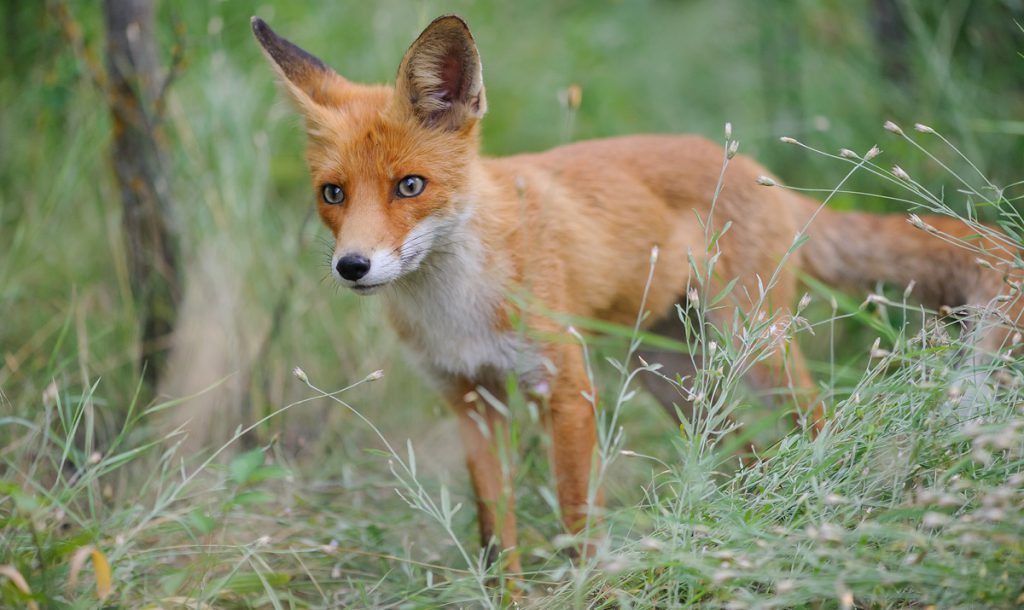
Foxes are adorable, lively, and quirky animals. So it is no surprise they have become a trendy pet to show off on social media. However, there is more to fox ownership than cute Instagram posts. This article will examine what is needed to care for a fox and if foxes make good pets. Or if a stuffed animal fox is a better idea.
Types of foxes and where they live
Foxes are medium-sized, omnivorous animals found on every continent except for Antarctica. This widespread distribution has made foxes prominent in many cultures, societies, and folklore worldwide.
Foxes are part of the Canidae family (Canids), in the subfamily Caninae, along with domestic dogs, wolves, jackals, and more. Physical characteristics differ slightly between species, but most foxes have a flattened skull, pointed snout and ears, and a long, bushy tail. Unlike other members of the Canidae family, foxes also have partially retractable claws.
There are 12 “true foxes” that fall into the genus Vulpes. However, approximately 25 extant and extinct members of the Canidae family are referred to as “foxes.” The most common Vulpes species is the red fox, with about 47 subspecies. Below are examples of Canid species known as foxes and where they are found.
Vulpes
- Arctic fox – Arctic regions of the Northern hemisphere
- Fennec fox – Deserts of North Africa
- Red fox – North America, Europe, Asia, and parts of North Africa
- Swift fox – Western grasslands of North America
- Bengal fox – Indian subcontinent
- Blanford’s fox – Middle East and Central Asia
- Cape fox – Southern Africa
- Corsac fox – Central Asia
- Kit fox – Southwestern United States and Mexico
- Pale fox – African Sahel
- Tibetan sand fox – Tibetan Plateau, Ladakh plateau, Nepal, China, Sikkim, and Bhutan
- Ruppell’s fox – North Africa, Middle East, and southwestern Asia
Canis
- Ethiopian wolf (also called Simien fox or Simien jackal) – Ethiopian highlands
Cerdocyon
- Crab-eating fox – South America
Urocyon
- Gray fox – North and Central America
- Island fox – Channel Islands of California
- Cozumel fox – Western hemisphere
Lycalopex
- Culpeo or Andean fox – South America
- Darwin’s fox – Nahuelbuta National Park, Cordillera de Oncol, Cordillera Pelada, Chile, and Chiloe Island
- South American gray fox – South America
- Pampas fox – South American Pampas
- Sechuran fox – South America
- Hoary fox – Brazil
Otocyon
- Bat-eared fox – African Savannah
Dusicyon
- Falkland Islands wolf (extinct)
What do I need to care for a fox?
To care for a pet fox, it is essential to accommodate its dietary, habitat, and lifestyle requirements. These vary depending on the species of fox. However, the information discussed below will focus on general requirements.
Fox diet
Foxes are omnivores. This means that they can survive by eating both plant and animal matter. However, most foxes are predators, so they hunt for food and eat a lot of meat and protein. Their primary food sources include invertebrates (e.g., insects) and small vertebrates (e.g., rodents). They may also eat eggs and vegetation, such as fruits and berries.
In captivity, it is essential to provide similar protein sources. It is possible to supplement a fox’s diet with high-quality dog food, but it is necessary to offer fresh meat or fish several times a week to keep them nourished. The diet must also contain a good amount of taurine, an amino acid in meat, fish, and dairy. It is vital for heart and brain function, and if foxes do not get enough, they can have seizures, go blind, or die. Food sources high in taurine include liver, eggs, chicken hearts, gizzards, shellfish, etc. Owners must also ensure foxes are eating enough. Most species consume around 1 kg (2.2 lbs) of food daily.
In addition to food requirements, foxes also have specific dietary habits. Foxes are foragers, so they are used to searching and hunting for food. This habit does not change with domesticated foxes. Therefore, owners cannot simply leave a bowl out for foxes to eat. Instead, they must simulate the foraging process. A way to do this is by hiding the food in something the foxes must destroy to get to it.
Fox habitat
Foxes are high-energy animals that require a lot of outdoor space to thrive. Foxes may tolerate being indoors, but they must be supervised because foxes are often destructive and like to mark their territories with urine. Creating an enclosure is probably the best option for pet owners. It allows the fox to explore and play outside while being protected from predators.
The enclosure size depends on the type and amount of foxes, but there should be at least 75 square feet of space in any enclosure. More space is beneficial, especially if there is more than one pet. Enclosures should also have enrichment features such as toys, ramps, platforms, tunnel tubers, etc., to keep the foxes entertained. Foxes are likely to become upset and destructive without adequate space and enrichment.
Other enclosure requirements include a closed-off roof and thick fencing to avoid it being chewed through. Foxes are also good diggers, so the floor should be dig-proof (e.g., lined with a chain link fence). The enclosures must also be cleaned frequently. Therefore, owners must ensure they have the space and resources to adhere to these enclosure conditions.
Fox behavior
Foxes have many behaviors that make them desirable as a pet. They are playful, loveable, and affectionate. When domesticated, they tend to bond with their owners and become reliant on them while maintaining independence. In the wild, they are not always found in packs, and some species (e.g., arctic fox) are known to be solitary, so it may not be necessary to adopt more than one. However, there also exhibit unwanted behavior as well.
Foxes can be noisy, destructive, smelly, and difficult to train. One of the main complaints is their scent marking. Foxes have a natural musky smell that some may not enjoy, but their enclosures are where owners will likely have the most significant issues with odor. Foxes like to mark their territory; the urine scent has been compared to when a skunk sprays. Some may find success in litter training, but it is not common. Having foxes indoors is likely to result in destruction and scent marking throughout the house, which is virtually impossible to get out of furniture and carpets.
Foxes are also loud animals. Vocalizations include whines, yelps, growls, barks, and more. They can get quite loud, especially in large groups, and foxes are nocturnal. This means that owners must be prepared to hear these vocalizations at night. Fox’s temperament can also be unpredictable. They are known to bite if they feel intimidated or irritated. They may also become territorial and attack pets, people, or other foxes.
In terms of health, foxes require similar veterinary care to a dog. However, not every veterinarian has the training and experience necessary to care for one, so owners may need to find a specialized veterinarian. Annual rabies vaccinations and distemper boosters are essential. In addition, it is recommended that vets use killed vaccine variations, as the live-virus vaccine can be tough on a fox’s immune system. Remaining internal and external parasites can be treated with the same medications given to dogs.
Do foxes make good pets?
Foxes may make good pets for some people, but owning a fox is not easy and can be expensive. Purchasing a fox will cost anywhere from $500 to over $6,000, but this is only a fraction of the care costs. In addition, foxes must be fed a diverse, high-quality diet that meets their nutrition requirements and dietary habits. This can be expensive and time-consuming but may not be as demanding as other exotic pets. This is the case for habitat requirements as well. Foxes are small and do not require overly large amounts of space, but adequate and well-equipped enclosures are needed to thrive.
Behaviour is probably one of the biggest hurdles with fox ownership. If treated right and provided with the necessary elements to thrive, foxes can be great pets. They are energetic, affectionate, and lively. However, they are also stubborn and challenging to train. Additionally, they can be loud, destructive and unpredictable. Therefore, owners must be determined and have the patience to teach them. Foxes also do not have long lifespans in the wild, typically living for three or four years. However, in captivity, this can extend up to 14 years. Therefore, owners must be prepared to commit to this before purchasing a fox.
Finally, legality and ethics are also concerns. Owning a fox is illegal in some provinces, states, and countries. (See which U.S. states fox ownership is allowed) In areas where it is legal, there are often specific rules and regulations dictating fox ownership, from care requirements to species restrictions. However, owning a fox is not the norm, so finding appropriate veterinary care in your area may be challenging. There are also ethical concerns when buying a fox. As fox ownership becomes more popular, so does unethical breeding. Therefore, it is essential to ensure the fox is purchased from a reputable breeder.
Enjoy a fox stuffed animal instead
If you want to enjoy the cuteness of a fox without the commitment, consider buying a fox plushy instead. A stuffed animal fox is soft, snuggly, and perfect for cuddling. It is an excellent option for any woodland animal lover in your life.
